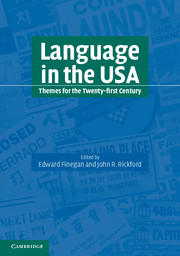Book contents
- Frontmatter
- Contents
- List of figures
- List of tables
- List of contributors
- Acknowledgments
- Foreword
- Editors' preface
- Part 1 American English
- 1 American English: its origins and history
- 2 American English and its distinctiveness
- 3 Regional dialects
- 4 Social varieties of American English
- 5 African American English
- 6 The Dictionary of American Regional English
- Part 2 Other language varieties
- Part 3 The sociolinguistic situation
- Index
1 - American English: its origins and history
Published online by Cambridge University Press: 05 June 2012
- Frontmatter
- Contents
- List of figures
- List of tables
- List of contributors
- Acknowledgments
- Foreword
- Editors' preface
- Part 1 American English
- 1 American English: its origins and history
- 2 American English and its distinctiveness
- 3 Regional dialects
- 4 Social varieties of American English
- 5 African American English
- 6 The Dictionary of American Regional English
- Part 2 Other language varieties
- Part 3 The sociolinguistic situation
- Index
Summary
Editors' introduction
This chapter explores the origins and history of American English, with an underlying focus on its linguistic diversity. Guaiacum, taken from the Taino language in the Bahamas in 1533, was the first American word to enter the English language. But, as Richard W. Bailey notes, English speakers migrating to the North American mainland and the Caribbean from the seventeenth century on had many other contacts with Native American languages, and influences from Native American languages on American English vocabulary were extensive. They include words like chocolate, canoe, and powwow, which have survived to the present day, and words like mangummenauk (an edible acorn) and netop (‘a good friend’), which have not survived.
This chapter surveys the population growth and linguistic development of the USA century by century, repeatedly acknowledging the inputs from its various ethnic strands: for example, bogus (African), juke-box (African American), cookie (Dutch), bayou (French), macaroni (Italian), geisha (Japanese), vigilante (Spanish), lutefish(Swedish), and bagel (Yiddish). American English is more than the sum of inheritances from its input languages, of course, and this chapter details its many innovations, including initialisms like AIDS, manufactured words like Kleenex, derived forms like antinuclear, compounds like rock star, and shortenings like bra.
But at the heart of the story throughout is the relative multilingualism and multidialectalism of the USA and its corresponding linguistic attitudes and ideologies. In the seventeenth century, for instance, pidgin-like varieties of English were exemplified among both Amerindian and African speakers, and there was open respect for linguistic diversity and substantial interest in it.
- Type
- Chapter
- Information
- Language in the USAThemes for the Twenty-first Century, pp. 3 - 17Publisher: Cambridge University PressPrint publication year: 2004
- 8
- Cited by



